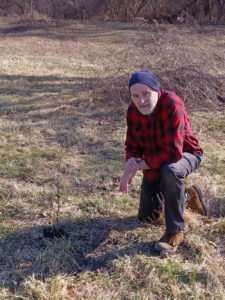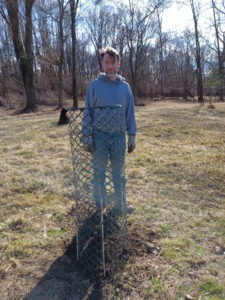By Joe Byrne
Today, with the help of a volunteer (Adam) I was able to get to a little project I’d been meaning to do for a while now. We transplanted some trees along the north fence of the cemetery, in the north-west quadrant.
On the other side of the north fence is an industrial site, including a lot of rusting equipment and shipping containers, as well as a mountain of shredded rubber tires. I thought it would be great to put up some trees to screen the cemetery from the industrial site. My idea was to use two different kind of trees: a top-canopy tree and a mid-level canopy tree. The two trees together, in two parallel rows, would provide a better screen than just the tall trees. The trees would have to be native and it would be great if they were already present in the cemetery. It would also be good if they could withstand the polluted run-off from the industrial site. Even better would be trees that would be unattractive to deer, so the deer wouldn’t crop the trees, or damage the tender trunks by rubbing off the bark with their horns (it’s the bucks that do that, not the does). A few years ago we planted some white pines along the north fence. A few still remain but quite a few of them died due to run-off pollution and damage from deer.
In the cemetery, we found some seedlings that I think fit the criteria listed above. For the top canopy tree, in a row of four closest to the fence, we transplanted some sycamore seedlings. There is already a very large sycamore tree along the north fence and it seems to be doing well. However we figured the very young sycamore trees would initially be susceptible to deer damage, so we put fences around them.
I’ve been experimenting with tree fencing for a while now. Putting up wooden posts and putting metal fencing around them does a pretty good job at protecting the trees, but that’s a lot of work, and it’s unsightly. The alternative I’ve come up with is to use leftover green plastic fencing (a kind of chicken mesh), and s’more sticks (doll rods) that we found at the Maryland Food Bank once upon a time. You cut of a length of fencing, use cheap wire ties to make it a closed circle. Then weave a s’more stick into the fencing and push it into the ground. Do three more in a circle (really, a diamond). After that, secure the bottom of the fencing with metal tent stakes. I found that, with just the s’more sticks, the fencing will topple over in a strong wind. With stakes, they stay upright and secure. The fencing looks kind of flimsy, but it looks solid enough to fool the deer. They could knock it down if they wanted to, but they don’t seem to want to. Even better, from a distance you can hardly see the green fencing.
After we had all the sycamore seedlings in, and fenced off, we planted four red bud trees in a row in front of the sycamores. Red buds are typically about half as high as mature sycamores. We already have some mature red buds in the cemetery, and they produce a lot of seedlings. I’ve transplanted some red bud seedlings before and noticed that the deer don’t mess with them. It might be that when they get bigger, the deer (the bucks) will go after them; so fencing might be necessary later. But for this planting, we left them without fencing.
One project done, but there are still plenty of places to plant more trees in the cemetery. Next time we plant trees, we’ll put the word out so that some those reading this might help out.




